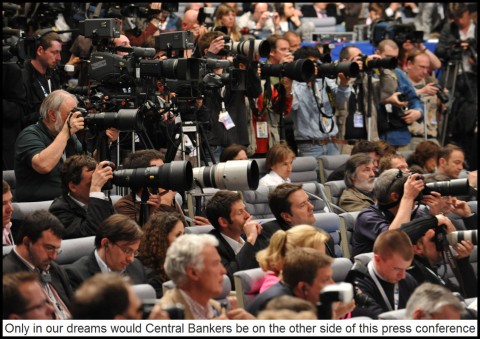There was good news yesterday for taxpayers, sort of: the Federal Reserve turned $76.9 billion in 2011 profits over to the U.S. Treasury. The not so good news is that it amounts to a meager 2.6% return on the Fed’s $2.9 trillion portfolio. That may be better than George Soros and John Paulson did last year, but at what risk? Keep in mind that quite a few of the paper “assets” the Fed holds are still radioactive, including a mountain of subprime mortgages that would fatally poison the U.S. banking system if they were returned to their rightful owners. Not that we even know who the rightful owners are; for in legal fact, the securitization mania of the past decade cast doubt on the title to each and every mortgaged home in America. Thanks to the Fed, however, our commercial banks needn’t worry about such things. That’s why they pay protection money to Bernanke, buying Treasury paper by the boatload so that everything gets taken care of. And what does the Fed care if it’s holding trillions of dollars’ worth of dodgy paper for the banks? It could write a check for Fannie and Freddie tomorrow and have enough left to over to buy every bank in Europe.
Unfortunately, this is effectively what the Fed has been doing via “swap” arrangements with the European Central Bank. The agreement is formally called a “temporary dollar liquidity swap arrangement,” but the actual mechanism, like laws and sausages, was not meant to be scrutinized. For if it were, it would make the most brazen Ponzi scheme look as squeaky clean as a Lutheran bake sale. Actually, compared to today’s high-level paper shufflers, Ponzi was a sap, working long hours to raise real money from new clients to pay old ones. The post-modern central bank, on the other hand, would never trouble itself to look for real money from real lenders. Not when the central banks can simply swap digital dollars with each other in unlimited quantities. And it’s not even called a loan. Americans might get upset if they thought the Fed was lending hundreds of billions of dollars to European banks. Instead, the swapped dollars go to the ECB (and the Japanese Central Bank), who can use it however they please. Mostly, this means giving it to multinational banks that have stopped lending to each other.
Epic Skimming Operation
For this…let’s call it a “favor,” the Fed charges 50 basis points — without calling it a…ahem…loan. The revenues could start to add up, since swaps are running at about $10 billion per week and climbing. We predict that the Fed will find a way to offset income from swaps come January 2013, lest the ‘Nank be embarrassed by unseemly gains. For, were such profits to leap above $100 billion, some curious congressman or reporter might ask where all that money came from. Better to underperform the hedgies than to incur their envy and awaken the muckrakers. For the Fed, this protection racket has been more lucrative than mere seignorage (the income derived from the difference between interest on securities and the cost of printing them). It is in fact nothing less than a skimming operation whose potential is as big as the growing sums required to allay fears of a global banking collapse.
***
(If you’d like to have these commentaries delivered free each day to your e-mail box, click here.)


Please cancel my Hidden Pivots and give a credit for recent billing of $106. Thank You Marion Cummins